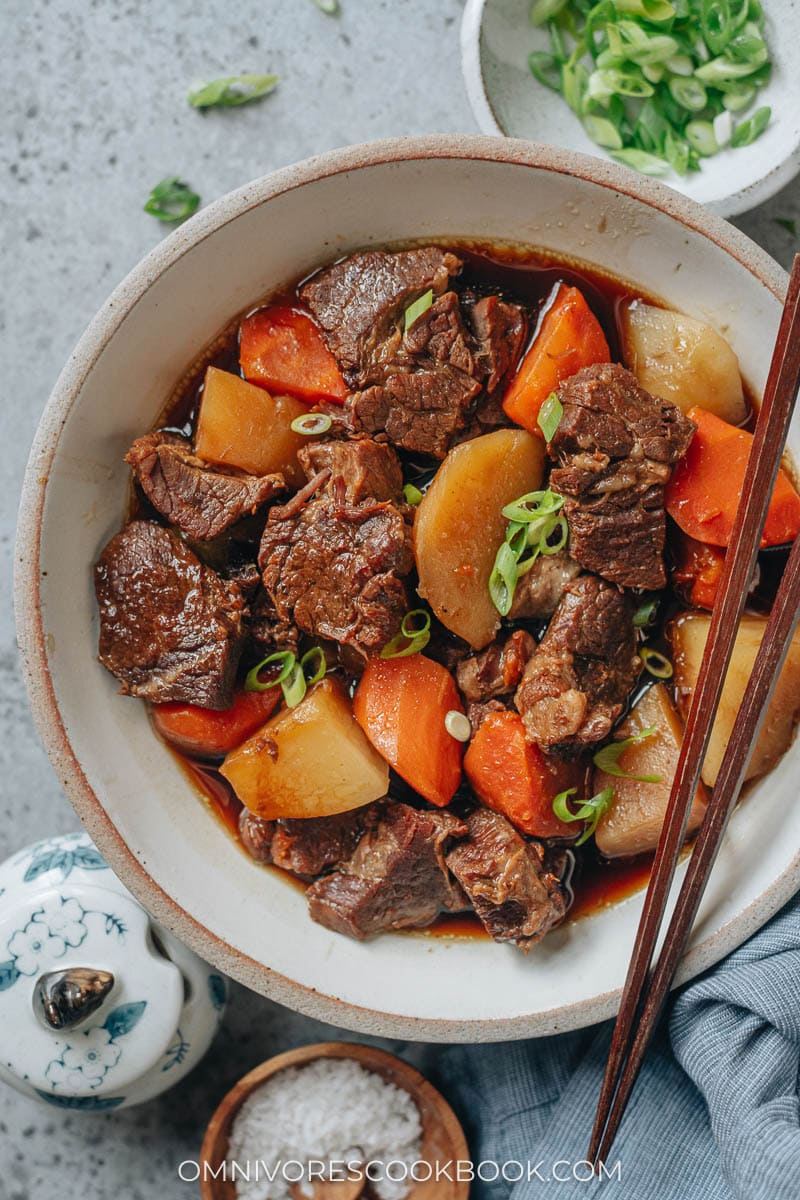
The beef is braised in a rich, savory broth with potatoes and carrots until super tender and flavorful. An easy make-ahead recipe that requires little prep, it’ll give you delicious dinners for the next couple of days. I include methods for making it in an Instant Pot or on the stovetop, so you can choose whichever works for you. {Gluten-Free Adaptable}
Chinese beef stew with potatoes and carrot is a dish I cook on repeat, especially during the colder winter months. The beef is briefly blanched to remove the impurities. It is then simmered with warm spices such as star anise and cinnamon, plus Shaoxing wine and soy sauce to create a dish full of umami. And I love the flavorful root vegetables that are braised in the beef broth, which is sometimes even more appealing to me than the beef itself.
The recipe was originally a stovetop recipe. But over the years I’ve found that the Instant Pot method is much easier and hands off. You can set it up and forget about it. And the result is just as wonderful.
I’ve included both methods, including with and without an Instant Pot, in my recipe below.
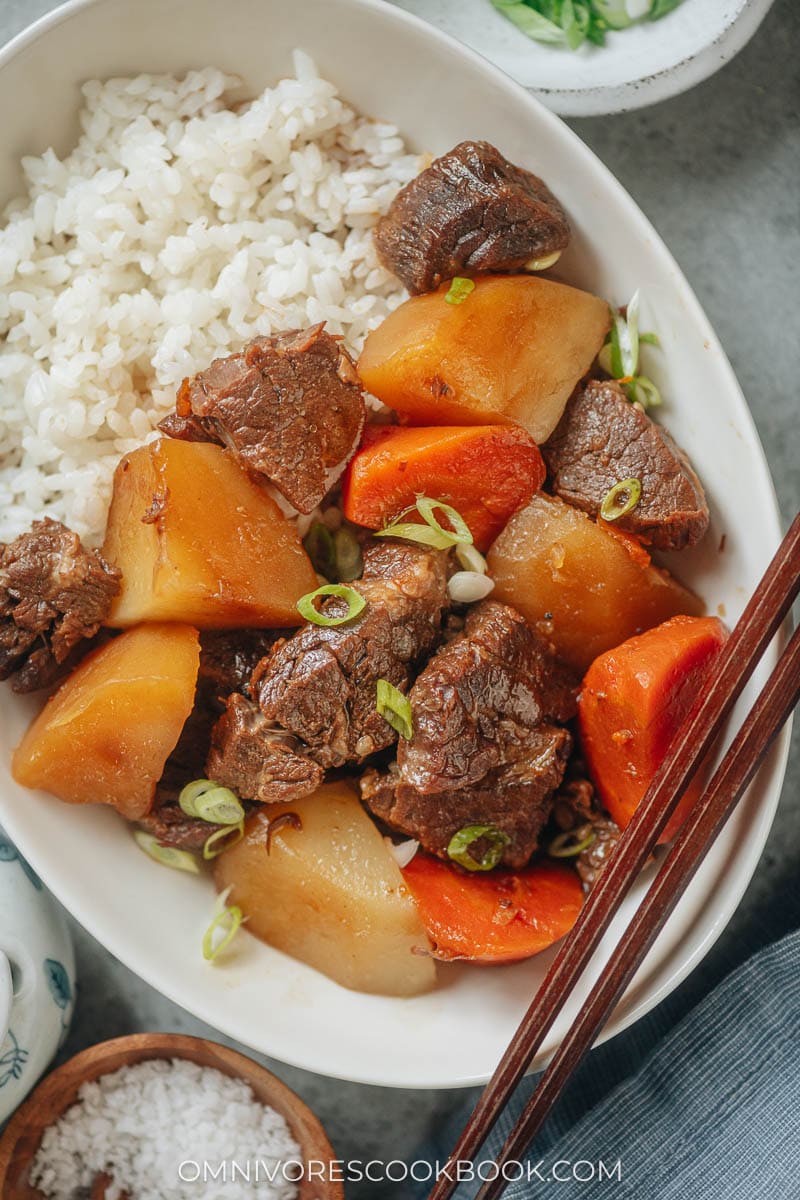
Chinese beef stew ingredients
1. What cut of beef to use
To make the best beef stew, you should use a cut that contains a good amount of fat and collagen. The fat keeps the lean part moist, and the collagen melts into a tender buttery texture once fully cooked. Both combine to create melt-in-your-mouth juicy tender chunks of beef.
A well marbled chuck roast or fatty brisket (usually called “second cut” or “deckle”) is the most affordable and convenient cut.
On the pricier end, oxtails and short ribs are excellent for beef stew. I did not include these two cuts in my recipe because they are quite expensive these days and I save them for special occasions.
Beef neck and shin bones are affordable options as well and produce excellent results. But you will get less meat, since a good third of each piece is bone weight.
Braising ingredients
The base of the braising liquid is made up of light and dark soy sauce and Shaoxing wine.
The dark soy sauce is quite important here since it gives the dish its appealing dark brown color, and it adds a hint of caramel flavor.
The green onion, ginger, bay leaves, star anise, cinnamon sticks, dried chili pepper, sugar and black pepper work together to create the ultimate umami that is warm and fragrant.
I included a mise en place picture below so you can see all the ingredients. But in reality, you do not need to portion out the ingredients into small bowls. Instead, simply add them as you cook the beef stew.
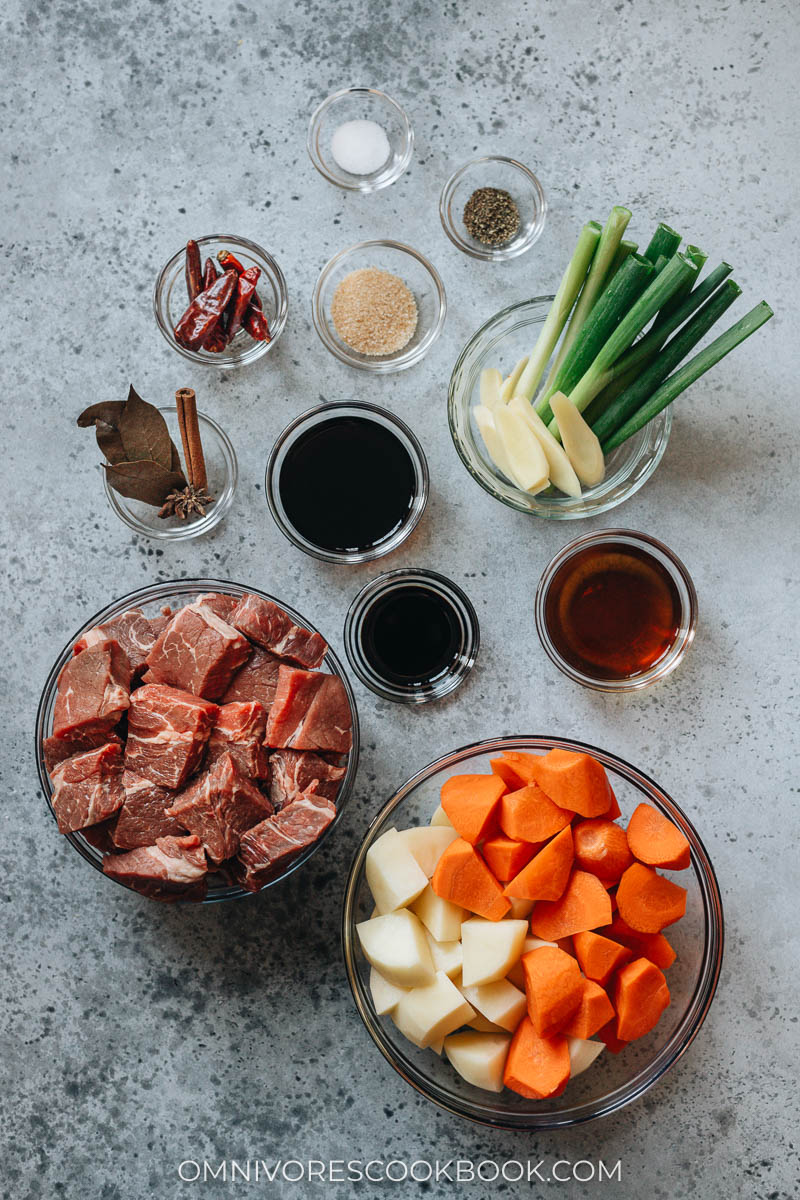
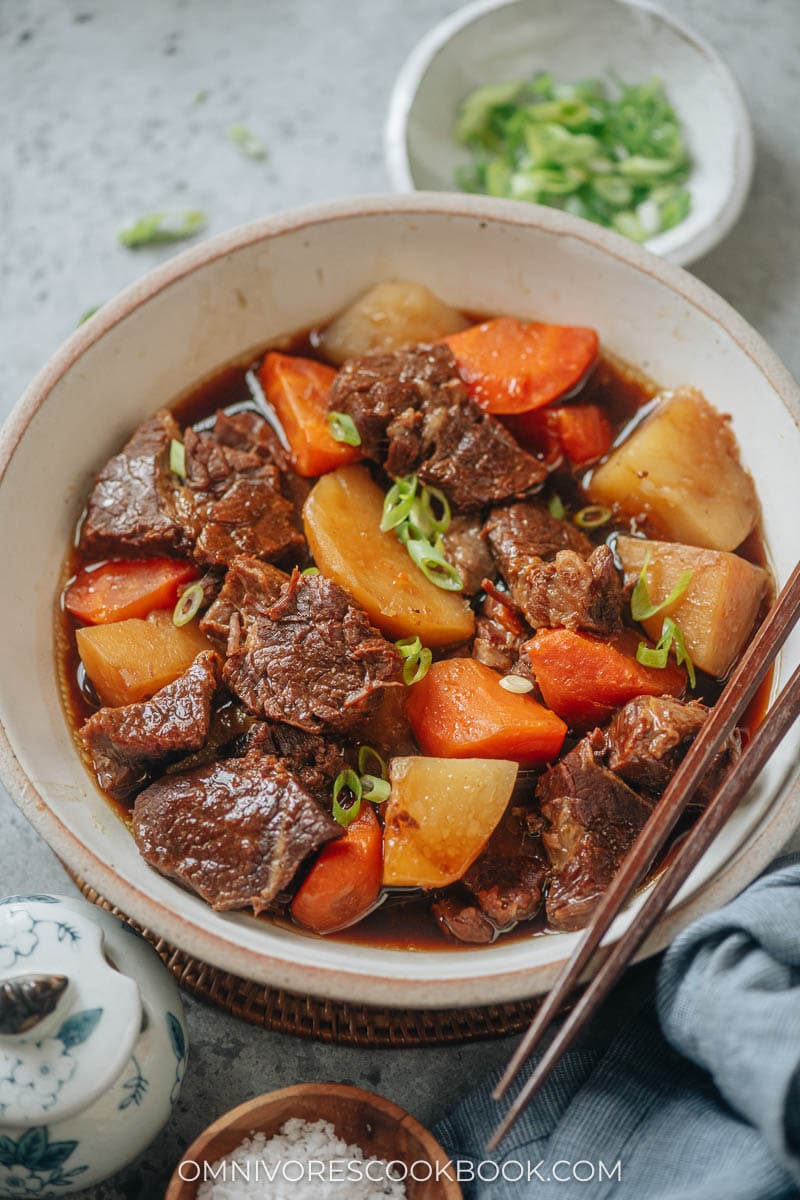
How to make Chinese beef stew
Making Chinese beef stew takes very little active time, especially if you make it in an Instant Pot:
- Cover the beef in cold water
- Boil the beef and skim the impurities
- Transfer the beef to an Instant Pot and add the liquid seasonings
- Add the rest of the spices and cook over high pressure until tender and flavorful
- Remove the spices
- Add the potato and carrot and pressure cook again until tender
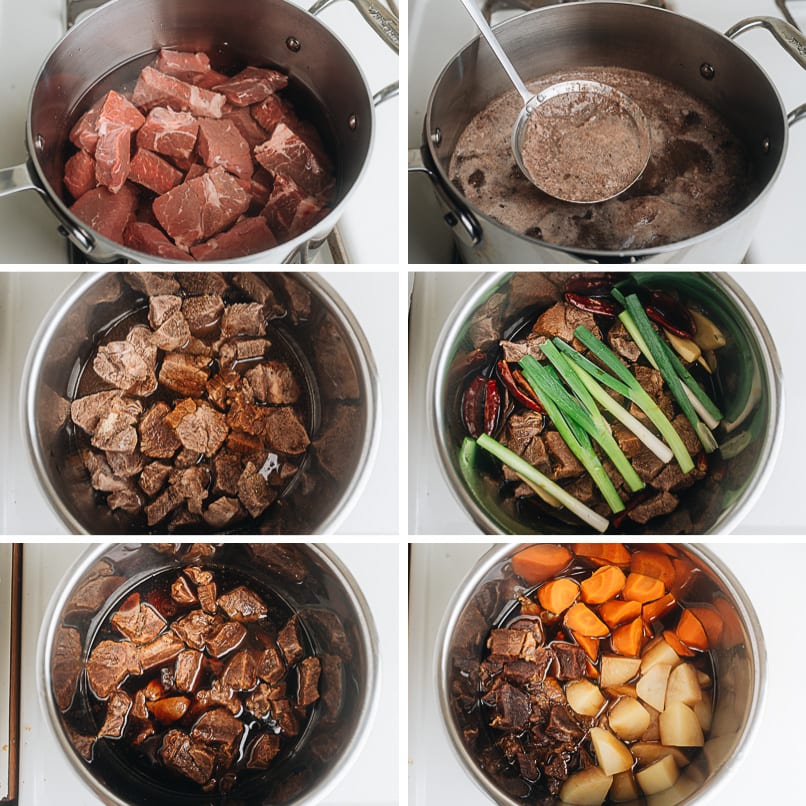
The stove top method is pretty much the same. Except that you do not need to transfer the beef once you skim off the impurities. And the braising will take longer.
How to serve beef stew
I have to admit that the Chinese beef stew tastes even better on the second day, when the root vegetables have soaked in the rich beef broth and become super flavorful. That’s why I always make a big batch, to ensure I have enough for leftovers.
You can simply serve the beef stew as a main course by itself, or over steamed rice or boiled noodles for a one-bowl meal.
I also like to make beef noodle soup by simply combining the beef stew, some water and some boiled noodles together in a bowl.
Once you finish the beef and the veggies, if you have extra sauce left, you can save it and add it to your stir fried vegetables. It is like an umami bomb that is no less flavorful than MSG.
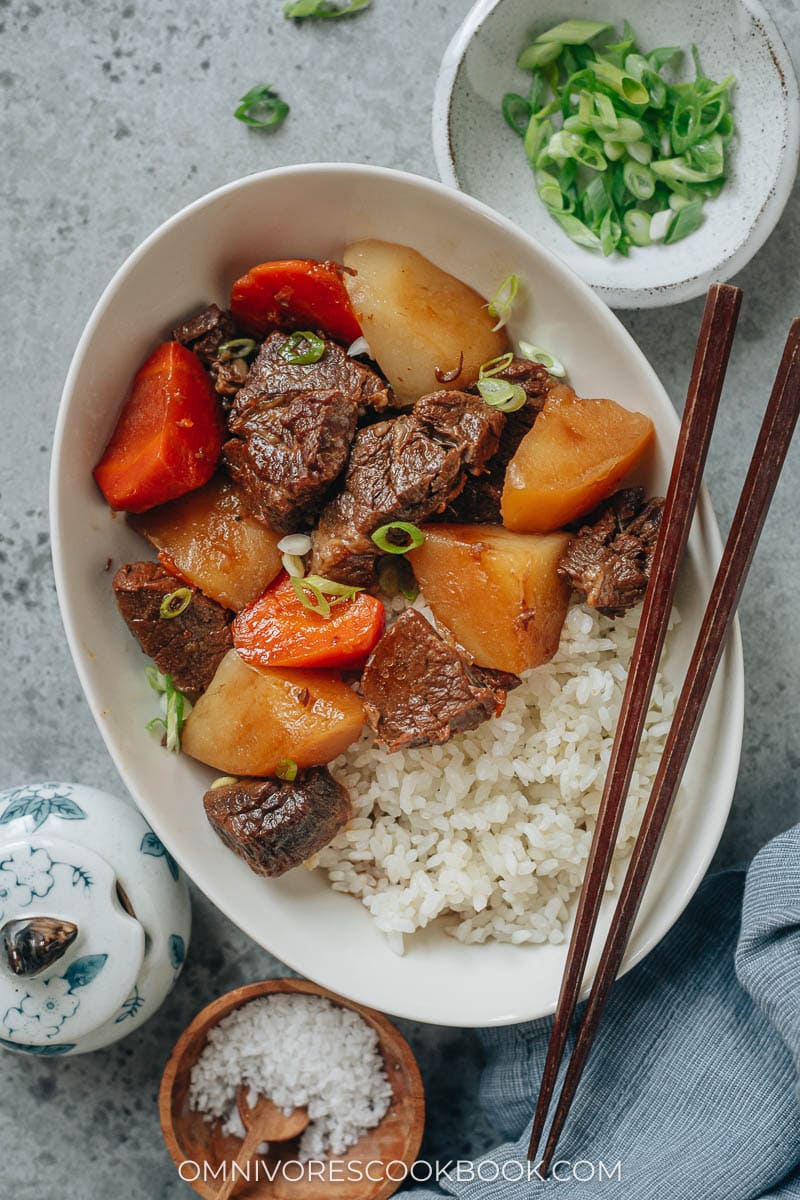
More braising recipes for bulk cooking
- Instant Pot Curry Beef Stew
- Chinese Oxtail Soup
- Chinese Braised Pork Trotters (红烧猪蹄)
- Coca-Cola Chicken Wings (可乐鸡翅)
- Korean Instant Pot Short Ribs (Galbi Jjim)
- Hong Shao Rou (Red Braised Pork, 红烧肉)
Chinese Cooking Made Easy
Are you new to this website? This free email series is a great place to start. I’ll walk you through a few of my most popular recipes and show you how and why they work. You’ll quickly start to cook better Chinese food in your own kitchen.
Watch video
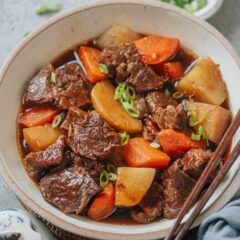
Chinese Beef Stew with Potatoes (土豆炖牛肉)
Ingredients
- 1 beef chuck roast (2 to 3 lbs / 1 to 1.3 kg) , cut into 1.5” (3 cm) chunks (or brisket, neck bone, shin bone)
- 1/4 cup Shaoxing wine
- 1/4 cup light soy sauce (or soy sauce)
- 1 tablespoon dark soy sauce
- 1 tablespoon sugar
- 1/2 teaspoon coarsely ground black pepper
- 1/2 teaspoon salt
- 6 dried chili peppers
- 1 thumb ginger , sliced
- 3 green onions , halved crosswise
- 4 bay leaves
- 1 star anise
- 1 cinnamon stick
- 2 medium waxy potatoes , cut into 2” (5 cm) pieces (or 1 large russet potato)
- 1 large carrot , cut into 2” (5 cm) pieces
Instructions
- Place the beef in a 4-qt (3.78-L) dutch oven or large pot. Add 4 cups of cold tap water so the water just covers the beef. Heat the pot over medium-high heat until it reaches a gentle boil. Stir occasionally to prevent the beef from sticking to the bottom of the pot. Turn to medium heat. Let it boil gently for 10 to 15 minutes. While boiling, skim the foam from the top of the broth and discard it until the broth is clear.
To make the dish in an Instant Pot
- Transfer the beef and 1 cup of broth from the beef boiling water to your Instant Pot.
- Add the Shaoxing wine, light soy sauce, dark soy sauce, sugar, black pepper, and salt. Stir a few times to distribute the ingredients evenly.
- Add the dried chili pepper, ginger, green onions, bay leaves, star anise and cinnamon stick. Make sure most of the dried spices are submerged in the liquid.
- Seal the Instant Pot. Set the pressure to high, and the timer for 40 minutes for chuck roast, 50 minutes for neck and shin bones, and 60 minutes for brisket.
- Once cooked, let release pressure naturally, for at least 20 minutes, before using manual release.
- Remove the green onion, ginger and spices as much as you can and discard them.
- Move the beef pieces to one side of the pot. Add the potato and carrot and submerge them in the broth as much as you can.
- Seal the Instant Pot again. Set the pressure to high and timer for 2 minutes.
- Once cooked, let release pressure naturally, for at least 20 minutes, before using manual release.
To make the dish on the stovetop
- Add the Shaoxing wine, chili peppers, ginger, green onion, bay leaves, sugar, dried chili pepper, black pepper, ginger, green onions, bay leaves, star anise and cinnamon stick (*Footnote 1). Turn to medium-low heat. Let simmer, covered, for 40 minutes for chuck roast. Simmer for 60 minutes for brisket, neck or shin bones.
- Add the light soy sauce, dark soy sauce, and salt. Stir to mix well. Continue simmering uncovered until the beef turns tender but not to the point of falling apart, about 1.5 hours for chuck roast, and 2 hours for brisket, neck or shin bones.
- Remove as much as ginger, green onion and the dried spices as possible and discard them. Add the carrots and potatoes. Simmer uncovered for another 20 to 30 minutes or so, until the veggies are tender.
Serve and store
- Serve hot as a main over steamed rice or boiled noodles. You can also use the beef stew to make noodle soup by adding more water to the broth.
- The beef stew can be stored in the fridge for 3 to 4 days, or in the freezer for up to 3 months.
Notes
- Adding salt and ingredients that contain salt will make the beef take longer to turn tender. That’s why the soy sauce and salt are added later.
Nutrition

Did you make this recipe?
I’d love to hear how it turned out for you! Please take a moment to leave a 5-star rating ⭐️ and share your thoughts in the comments further down the page. It really helps others discover the recipe too.

Alicia
Just tried this recipe this week and it’s going on repeat this winter. I did some meal prep and pre-boiled the meat then threw it and all the spices and sauce ingredients in a ziploc bag to dump in the pressure cooker a few nights later. Not sure if that extra time sitting in the sauce and spices increased the flavor at all, but it was so chock full of flavor I was honestly a bit surprised. (Maybe because the skimmed “broth” felt more like murky water than broth to me). I’d put chili oil on the table, but it wasn’t needed. Even my husband who always wants more spice left the chili oil alone. The icing on the cake was how simple it was and that I could do the most time consuming parts (not that they took that long) in advance for meal prep.
Maggie Zhu
I do think leaving the ingredients and cook later give the spices time to infuse the broth. When I make the stew, it always taste better the second day, when the spices blend in more.
I’m so happy to hear you enjoyed the dish and thanks for leaving a postive review 🙂
Ally
Hi can I cook this in the slow cooker ? If so what do you recommend the method is?
Thanks
Maggie Zhu
You definitely can make it in a slow cooker. After blanching the beef in step 1, follow the steps of “Instant pot” using a slow cooker, plus you can also add the potato and carrot together at this point, cook on low for 7 ½ to 8 hours or high for 3½ to 4 hours.
Tracey
Everyone loved this. Personal taste – but we love gravy. So next time I’ll add more of the stock water . Thanks for the recipe
Sarah
I made this last night for dinner and it was amazing! I made it in the instant pot and the only feedback I have was that it was a bit light on sauce, having only added 1 cup of broth from the initial boiling stage. Next time I will add another half cup and adjust the ratio of the other sauce ingredients/spices to suit
Linda
Delicious! Easy to make and my husband and I both really enjoyed it. Seasoning tastes authentic and he even went back for seconds–thanks!